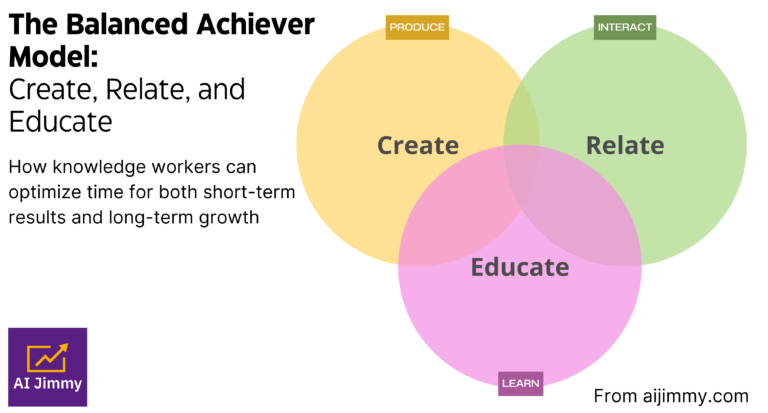The Balanced Achiever Model for Time Management

In the tech industry, I’ve seen employees get stressed because they can’t prioritize everything in the available time in the day. People say things like:
- “No time to learn! Too much work and too many meetings!”
- “No time for ‘real’ work! Too many mandatory meetings and trainings!”
- “No time to meet people! Too much work and things I need to learn!”
For a better future, I want to introduce to you my Balanced Achiever Model for time management. It’s a framework to get the most from our finite working time to achieve both short-term results and long-term growth.
Introducing the Balanced Achiever Model
I’ve realized that the time that people spend at work falls into three general categories of purpose, which often need tradeoffs to balance:
- Produce results now
- Communicate, coordinate, and collaborate via meetings, emails, etc.
- Learn new skills for better results in the future
Together, these three distinct purposes help us achieve both our short-term work goals and our long-term growth goals, so long as they are properly balanced.
 Venn diagram of the Balanced Achiever Model from the author
Venn diagram of the Balanced Achiever Model from the author
For the Balanced Achiever Model, see this Venn diagram of how knowledge workers, such as engineers and marketers and others, spend their time in the work day.
- Create: produce deliverables
- Relate: interact with others
- Educate: learn new skills
I believe all work activities fall into these three categories, and that a balanced mix of all three categories is important in a healthy, productive, growing career.
1. Create: produce deliverables
My job, and any job, is to create something of value. The process of creating, whether for building software or planning the next project, always requires time.
- In my role as a data science leader, the main deliverables were data science project code, analyses, and recommendations.
- For other types of jobs, the deliverable could be any product or service so that the business and customers can get a direct benefit. E.g. medical diagnosis, legal contract, art, or a new hire.
Whether entrepreneur, or enterprise employee, the expectation is to deliver something valuable to people. By using time to create and produce things of value, workers can achieve desirable outcomes for their business and themselves, including income.
2. Relate: interact with others
My job, and likely any job, requires relating with others. This means interacting and communicating with people. Whether a one-on-one meeting with my boss, or an email to stakeholders, these interactions take time.
In my data science role, we needed to frequently collaborate with product management, finance, marketing, sales, engineering, and others:
- “Daily stand-ups” and weekly status meetings
- Email status reports and monthly internal newsletters
- Multiple pre-meetings to pre-wire early buy-in before the “big” meeting
It wasn’t enough to build code and reports. It required much organizational alignment throughout the whole project lifecycle to both start and deliver projects. Multiple levels of multiple teams needed to nurture the adoption of new business processes and solutions.
Besides coordinating projects, we needed working relationships to flourish as new workgroups evolve through their “forming, storming, norming, and performing” stages. Relationships matter:
- One-on-one meetings with management, stakeholders, and team members
- Team offsites for strategic planning and/or team bonding
- Interviewing candidates and onboarding new hires
In all of these cases, interacting with other people and building solid relationships were crucial uses of time for the healthy functioning and growth of the organization.
3. Educate: learn new skills
We need to educate ourselves to grow our future impact. Learning new skills and trends takes time though, often while deferring our work deliveries and relationships.
Continuous learning is especially crucial in jobs where technologies, regulations, and marketplaces are continuously evolving. New medical advances. New laws. New cultural trends. And certainly new software and AI for all of us.
For example, in my previous role, across 12 years, we switched across 4 different database platforms for the data warehouse, with 5 dialects of SQL to learn. Three more if I count side projects. Besides database platforms, there were many other system, process, and industry changes too.
Here are a few examples of how I’ve invested time for continuous learning.
- Learned to use a Mac laptop in addition to Windows. My productivity suffered temporarily during the transition time and initial learning curve for the new tech environment. However, I’m now fluent in both environments for better future adaptability.
- Squeezed in online learning. LinkedIn recognized me with a “Super Learner” certificate for three years in a row, for being in the top few percentiles of employees who spent the most time on LinkedIn Learning courses. Frankly, I was able to squeeze in many of those LinkedIn Learning courses only by listening to the audio tracks at 2x speed at home while doing routine chores or exercising.
- Stayed on top of industry news and trends, and continued to refresh skills. I’ve used vacation days to go to conferences and training classes for cases where I needed to pay for them out of my own pocket.
In my examples, I invested in my learning and growth, but they required some tradeoffs to productivity and time spent in delivering short-term outcomes. However, these learning activities helped me to grow for more future capabilities.
 Image by sodawhiskey on Adobe
Image by sodawhiskey on Adobe
The Usual Tradeoffs
In each of these three purposes for our work time, we often face tradeoffs in how we choose to use our time.
- If we use our work time to only “create” while remaining heads down in our work…
Then we would fall behind in learning and adopting technology trends, limiting our future growth. Even healthcare practitioners, lawyers, and administrative assistants need to stay on top of new trends to stay effective. - If we use our work time to only “relate” and interact with others…
Then we’d be questioned about our ability to achieve tangible value for the organization. Although there’s value in solid relationships and project coordination, it’s not easy to directly measure its value to the organization. - If we use our work time to only “educate” ourselves to learn new things…
Then again the organization would question how we are directly adding immediate short-term value. It’s merely head knowledge if we don’t practice our new skills and don’t do something useful with it.
What we need is a balanced approach, including selecting activities that can serve multiple purposes at the same time.
Combining Multiple Purposes
Per the Venn diagram for the Balanced Achiever Model, we can pick activities where the Create-Relate-Educate circles overlap in order to serve multiple purposes at the same time. Examples:
- Create-Educate: run pilot projects to experiment with new things, practice existing skills in new work, and be retrospective about failures and successes
- Educate-Relate: get coaches/mentors and attend group study sessions, traditional classes, book clubs, conferences, and Toastmasters
- Relate-Create: run group brainstorming sessions, design reviews, pair programming, and other teamwork
When we find ways to serve multiple purposes with our working time, then we can achieve more from our time in a balanced way.
Here’s an example of multi-purposed time during the recruiting process. I’ve often asked job candidates “What would you have done differently?” after they share their most successful project. I’ve learned frequent lessons from the hindsight from these candidates while spending time evaluating and interacting with them.
I’ve asked a mentor, a VP of analytics at a martech company, about my observations for this work time allocation model. He shared that in his executive role, part of his job duties was to learn the industry trends and apply those learnings to his company. He chose to interact with vendor sales reps to learn from them as part of his role. Through this method, he shared that he was able to use his time for all three purposes of “create, relate, and educate” at the same time. Clever!
Where it make sense, let’s consider activities for multiple purposes for a balanced approach to achieve more from our time.
How to Use the Balanced Achiever Model?
Ideally, design your work day with activities that meet the three purposes of create, relate, and educate. I recommend a balanced approach in allocating time for these three purposes to achieve the best short-term outcomes and long-term growth, while staying connected with people.
Consider activities that can cover two or more purposes at the same time as previously mentioned. More examples:
- Lead group brainstorming sessions for a new project
- Participate in retrospective meetings for lessons learned
- Run a “hackathon” to form ad-hoc teams to prototype new innovations
These examples help the organization and individuals with learning and relationship building, while taking steps toward creating new innovations at the same time.
I anticipate AI will help us create deliverables and educate ourselves faster. However, people will still always need to relate to each other to build trust and rapport, negotiate different priorities, and use other distinctly human AI-proof skills. In your learning strategy, consider learning more of these people skills in addition to technical skills.
To stay as a balanced achiever, don’t remain heads-down in your work but also remember to set time for intentional learning as well as relationship building at work for best long-term outcomes.
Final Thoughts
As our working time is limited, we need to prioritize and balance our time spent to create, relate, and educate. Setting the right balance will help us to achieve our immediate work goals, invest in future growth, and build the relationships needed for mutual success.
With the Balanced Achiever Model, we can be mindful to allocate enough time for these three purposes, and even select some work activities to serve multiple purposes when it makes sense. This intentionality should also help us manage stress in prioritizing our time.
Originally published on my blog at aijimmy.com. Feature image by DCStudio on Freepik







